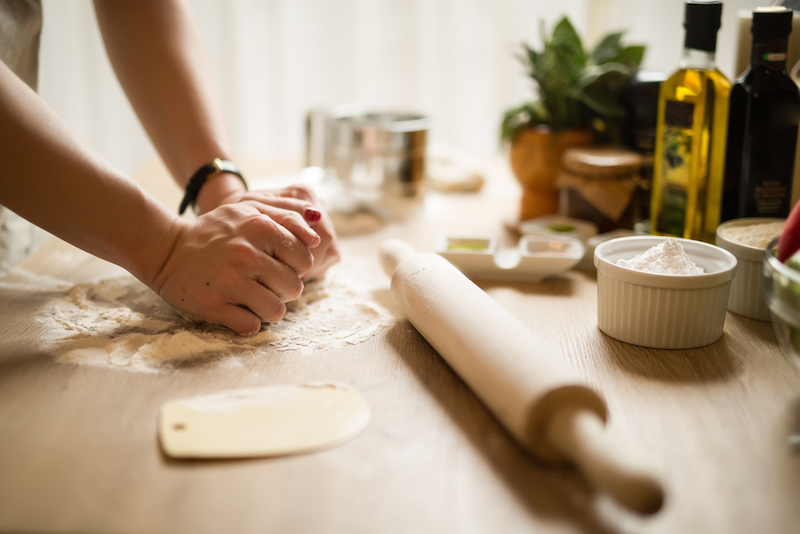Raw Food Warning: Why Uncooked Flour Can Make You Sick

The Food and Drug Administration recently made a perhaps surprising recommendation: Don't eat raw flour.
The warning issued last week came in response to an outbreak of E. coli that has sickened at least 42 people in 21 states since December. The FDA tracked the outbreak to a batch of General Mills flour sold under the brand names Gold Medal, Gold Medal Wondra and Signature Kitchens, triggering a recall.
Most people who read the recommendation probably already knew they weren't supposed to eat cookie dough because of the raw eggs in it (though people donꞌt always do what theyꞌre supposed to do). But the flour recommendation was flummoxing, particularly because of the FDA's explanation: Flour is a field food, the agency said in a June 28 consumer update. If pathogens get into the wheat plants while they are growing in a field — via wild animal waste, for example — they'll stay in through the milling process.
That advice makes sense. Except that people eat lots of field foods raw. If raw flour is dangerous, what about a spinach salad or a bowl of fresh strawberries? Why hasn't the FDA declared all raw foods a no-go? [Top 7 Germs in Food That Make You Sick]
Live Science spoke with an FDA expert and an outside food safety researcher who had the answers. Bottom line: Yes, salad can cause illness, and produce has been linked to many more outbreaks than flour. But the risk of illness from raw produce is better understood than the largely unquantified risk from grains. And fruits and vegetables are processed under the assumption that people will eat them raw, whereas flour isn't.
New awareness
The Centers for Disease Control and Prevention estimates that nearly half of foodborne illnesses are caused by produce. So why raise the red flag over flour?
"We just want to provide consumers with the best information to take steps to reduce their risk," said Jenny Scott, a senior adviser in the office of food safety at the FDA Center for Food Safety and Applied Nutrition. "The same thing happens when we have a produce outbreak."
Sign up for the Live Science daily newsletter now
Get the world’s most fascinating discoveries delivered straight to your inbox.
But the ways that people traditionally use flour did influence both the timing and the content of the recommendation. Typically, Scott told Live Science, people don't eat raw flour in large quantities.
"Because people donꞌt think of raw flour as being a concern, that's one of the reasons we're making the effort to get the information out," she said. The risk of illness from raw flour is low, she said, but then, so is the risk from raw produce.
The current flour-related outbreak is the second of two such outbreaks in the past seven years. The earlier one was a 2009 outbreak of another strain of E. coli caused by Nestlé Toll House prepackaged cookie dough, which — surprise, surprise — people were eating raw. Exhibiting a clear-eyed realism about human nature, Nestlé opted to start heat-treating all of the flour in its raw cookie dough.
Some recent changes in consumer behavior may explain the appearance of this newest flour-related outbreak, Scott said. Some pizzerias, for example, have started giving kids balls of raw dough to play with while they wait for their meals. But also, improvements in epidemiology now allow researchers to detect and track outbreaks that might have gone unnoticed in earlier years, she said.
"It happens once, you think, 'Well, that's a fluke, not really an issue,'" Scott said. "It happens twice, you start thinking, 'Hmm, maybe there is something here.'"
Known unknowns
Food safety experts are now aware of the flour risk, but are only beginning to understand it. Outbreaks related to produce have been studied intensively for two decades, starting with a massive outbreak of infection with the parasite Cyclospora in 1996 (it eventually was traced to raspberries imported from Guatemala). By comparison, there isn't much data on the prevalence of pathogens in flour, said Ben Chapman, a professor of food safety at North Carolina State University.
"Over 20 years, we have a pretty good understanding, or a better understanding, of fresh produce consumption, but when it comes to flour, we don't know," Chapman told Live Science. "It's hard to make risk-management decisions based on unknowns."
No one really knows how General Mills' flour became contaminated, or if contamination is a widespread problem among other brands. E. coli can spread through animal feces, so wildlife pooping in and around fields might be the culprit. But untreated irrigation water could spread the bacteria, too, Chapman said, or there could be some sort of cross-contamination during the milling process. No one knows how long E. coli or other pathogens persist in dry foods like flour, he said.
"It's still relatively new for us to be looking at this as a community," he said.
As for produce, which is currently responsible for far more outbreaks than raw flour, the FDA is making strides on safety. The agency recently released a new Produce Safety rule under the FDA Food Safety Modernization Act that requires specific water quality guidelines and testing for irrigation water, rules for manure and compost use, and standards related to worker hygiene and equipment and tools. Raw sprouts, the culprit in 42 outbreaks between 1996 and 2014, get special attention under the new rule. [Top 10 Science Buzzkills: Studies that Ruin Your Fun]
Grains aren't covered under the new Produce Safety rule, but both producers and regulators will likely be looking at ways to reduce the risk of contamination, Chapman and Scott said. Widespread heat-treatment of flour seems unlikely at this point due to the lack of infrastructure and technology to treat the grain supply, according to Scott.
But with huge grain-consuming companies like Nestlé and General Mills linked to outbreaks, producers will be examining their supply chains and processing practices, Chapman said.
"It's bad business, being linked to outbreaks," he said.
Original article on Live Science.

Stephanie Pappas is a contributing writer for Live Science, covering topics ranging from geoscience to archaeology to the human brain and behavior. She was previously a senior writer for Live Science but is now a freelancer based in Denver, Colorado, and regularly contributes to Scientific American and The Monitor, the monthly magazine of the American Psychological Association. Stephanie received a bachelor's degree in psychology from the University of South Carolina and a graduate certificate in science communication from the University of California, Santa Cruz.
